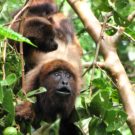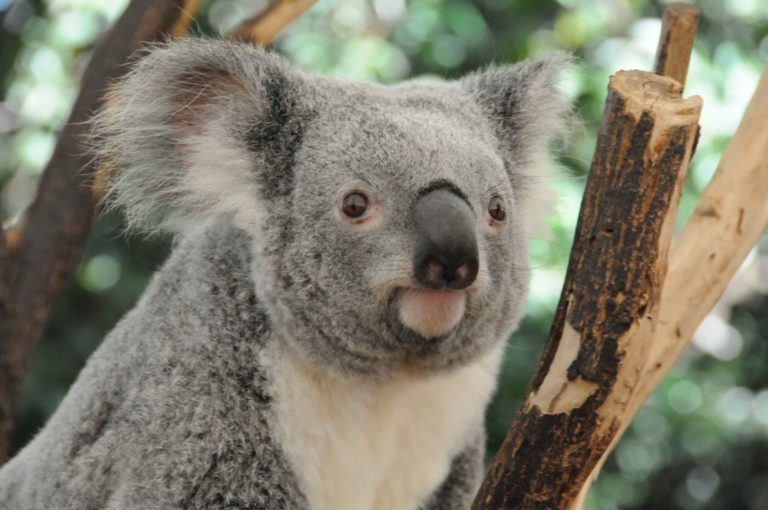TALLAHASSEE, Florida — Biologists Chace Holzheuser and Bruce Means are on their hands and knees in a Florida swamp, pawing through dark water, leaves and muck as cicadas hum unceasingly…
Growing more than two feet in length, the hellbender (Cryptobranchus alleganiensis) is the largest salamander species in North America. Hellbenders have been on the decline for at least 30 years,…
The red-backed salamander (Plethodon cinereus) is a creature of Earth, although a brief physical description can cast sufficient doubt. One deep red stripe runs the length of its body, though…
Any day now. That’s when Batrachochytrium salamandrivorans (Bsal), the “salamander-eating” fungus, is expected to arrive in the United States, home to more than a third of the world’s species of…
If you take a stroll in the woods, it’s worth pausing for a moment to take in the sights and sounds, peer into the undergrowth, or even turn over a…
Parrots around the globe are captured and sold as pets in a thriving illegal market that has carried more than 19 million birds across borders since 1975. The deadly beak…
Rising temperatures seem to have made a southern African park less hospitable to the tsetse fly (Glossina spp.), the carrier of a dangerous disease-causing microorganism, new research shows. Named for…
On this episode, we discuss the global outbreak of the chytrid fungus, which might have already driven as many as 200 species of frogs to extinction, but there have been…
Frogs in a tropical forest in Panama are doing better than scientists believed after a devastating fungus slashed population numbers and wiped out entire species about a decade ago. In…
On this episode, we look at research into an African bat that might be the key to controlling future Ebola outbreaks. Listen here: Our guest is Sarah Olson, an…
Armadillos are a popular bushmeat in the Brazilian Amazon, but handling and eating these scaly mammals could put humans at risk of leprosy, a new study published in PLOS Neglected Tropical…
Scientists have long suspected a relationship between deforestation and some infectious diseases. For instance, the 2014 Ebola crisis has been linked to logging that may have put workers and their…
Scientists started to get worried in the 1970s when frogs in Australia and Central and South America began disappearing. The culprit seemed to be a chytrid fungus that colonized frogs’…
Every year since 1993, Fabio de Oliveira Roque, one of the authors of this piece, has returned to his hometown of São Paulo, a big city inside a biodiversity hotspot…
In May 2015, more than 200,000 saiga antelope (Saiga tatarica) suddenly died. Entire herds perished, their bodies littering the steppe grasslands of central Kazakhstan as if dropped from the sky.…
A team of scientists from Seychelles, the United States and the United Kingdom has found a new caecilian, perhaps the smallest species of the legless amphibian on Earth. "As soon…
Bats have not historically been a focus of much conservation effort, but starting around 1985, conservationists in Canada and the United States began working to limit human access to bat…
It is regarded as the deadliest Ebola outbreak in human history: the 2014-2016 epidemic in West Africa claimed the lives of 11,325 people and resulted in 28,652 suspected, probable, and…
Great apes should be humanity’s best bet for conservation — charismatic, intelligent, strikingly familiar, with big emoting eyes. It’s hard to think of creatures with whom the public empathizes more…
The deadly yellow fever -- an infectious disease caused by a mosquito-borne virus -- has spread rapidly throughout Brazil, wiping out populations of the brown howler monkey (Alouatta guariba). Thousands of…
A type of transmissible cancer has decimated Tasmanian devil populations. First detected in 1996, the devil facial tumor disease (DFTD) has spread across most of the Tasmanian devil's range and has…
Koalas, the eucalyptus-loving cuddly marsupials found only in Australia, are declining rapidly. In some areas, their numbers have plummeted by more than 80 percent, with koala populations in the state of…
If current trends persist, the population abundance of mammals, birds, reptiles, amphibians, and fish could decline an average of 67 percent by 2020. That’s one of several sobering findings detailed…
A transmissible cancer -- the devil facial tumor disease (DFTD) -- has decimated Tasmanian devil populations. The contagious cancer, first recorded in 1996, has wiped out over 90 percent of…
For the first time since 1970, a team of scientists has reviewed global trends in bat mortality. Unprecedented in scope, the review, published in Mammal Review, reveals that over half…
ver the last four decades, industrial agriculture has been a boon to Southeast Asia, but it also helped destroy more than 30 percent of Borneo’s rainforest — one of the…
The United States and China have made an official, joint statement to sign Paris Agreement [BBC] This Thursday, the U.S. and China issued a joint statement regarding their commitment to…
The fatal white-nose syndrome (WNS) that has decimated bat populations across North America has now made its way to western United States. On March 11, a group of hikers discovered a…
Deforestation could be increasing risk of “monkey malaria” in humans in Malaysia, suggests a new study published in Emerging Infectious Diseases. Caused by the protozoan parasite Plasmodium knowlesi, and transmitted…
Amphibian lovers now have a reason to cheer. In the first victory of its kind, biologists from Spain and the U.K. have succeeded in treating the fatal chytrid fungus in…
































































